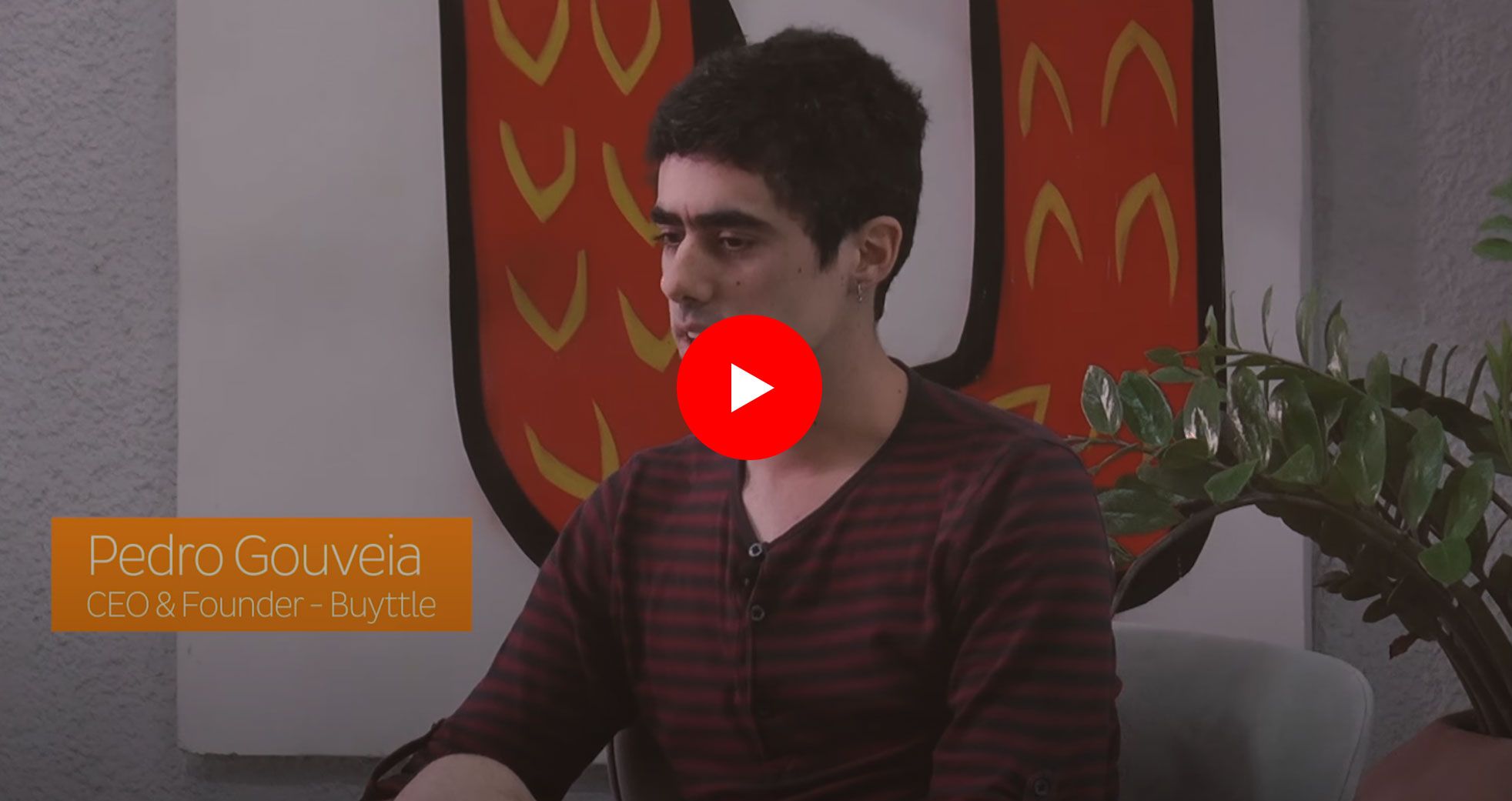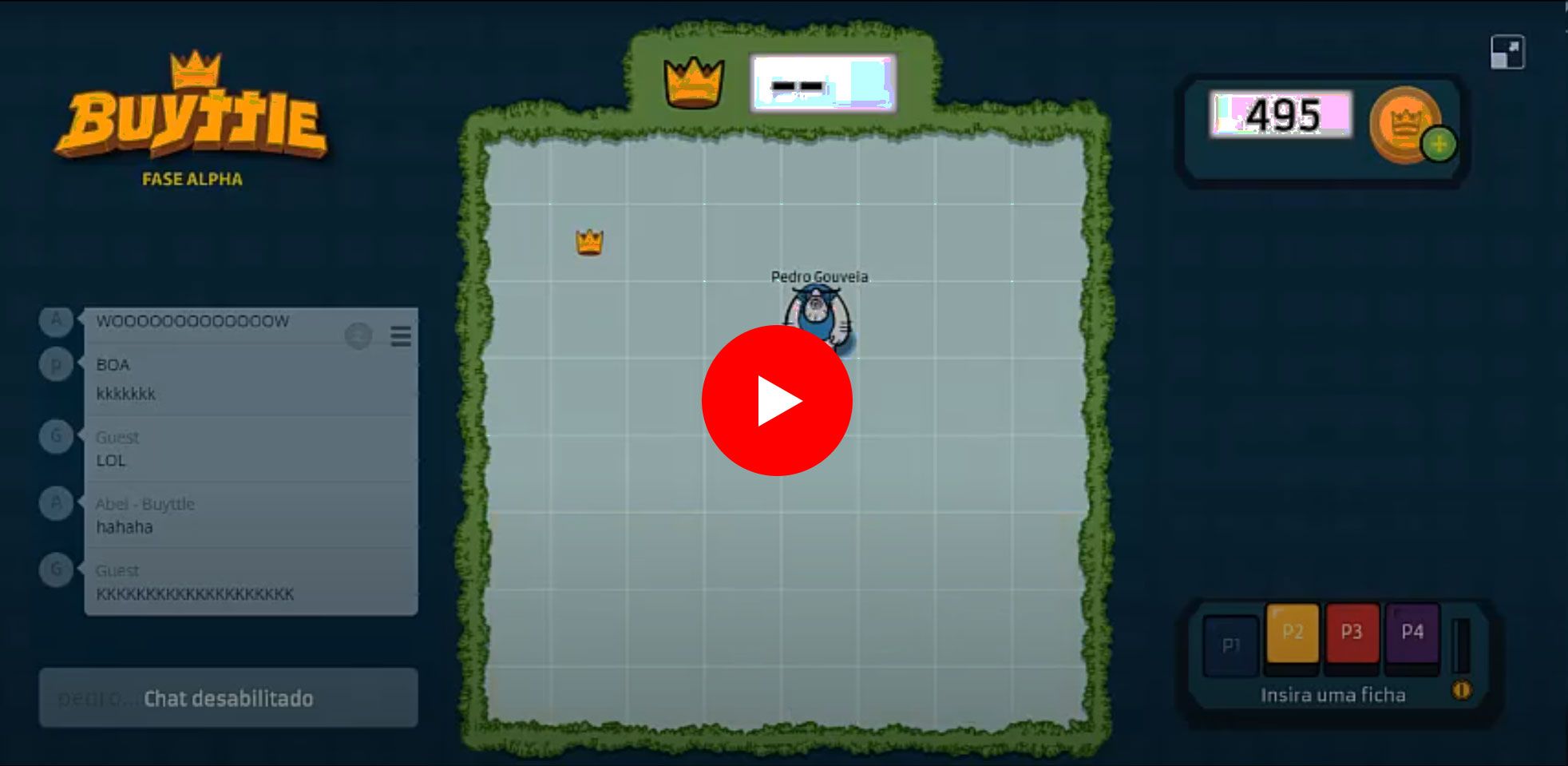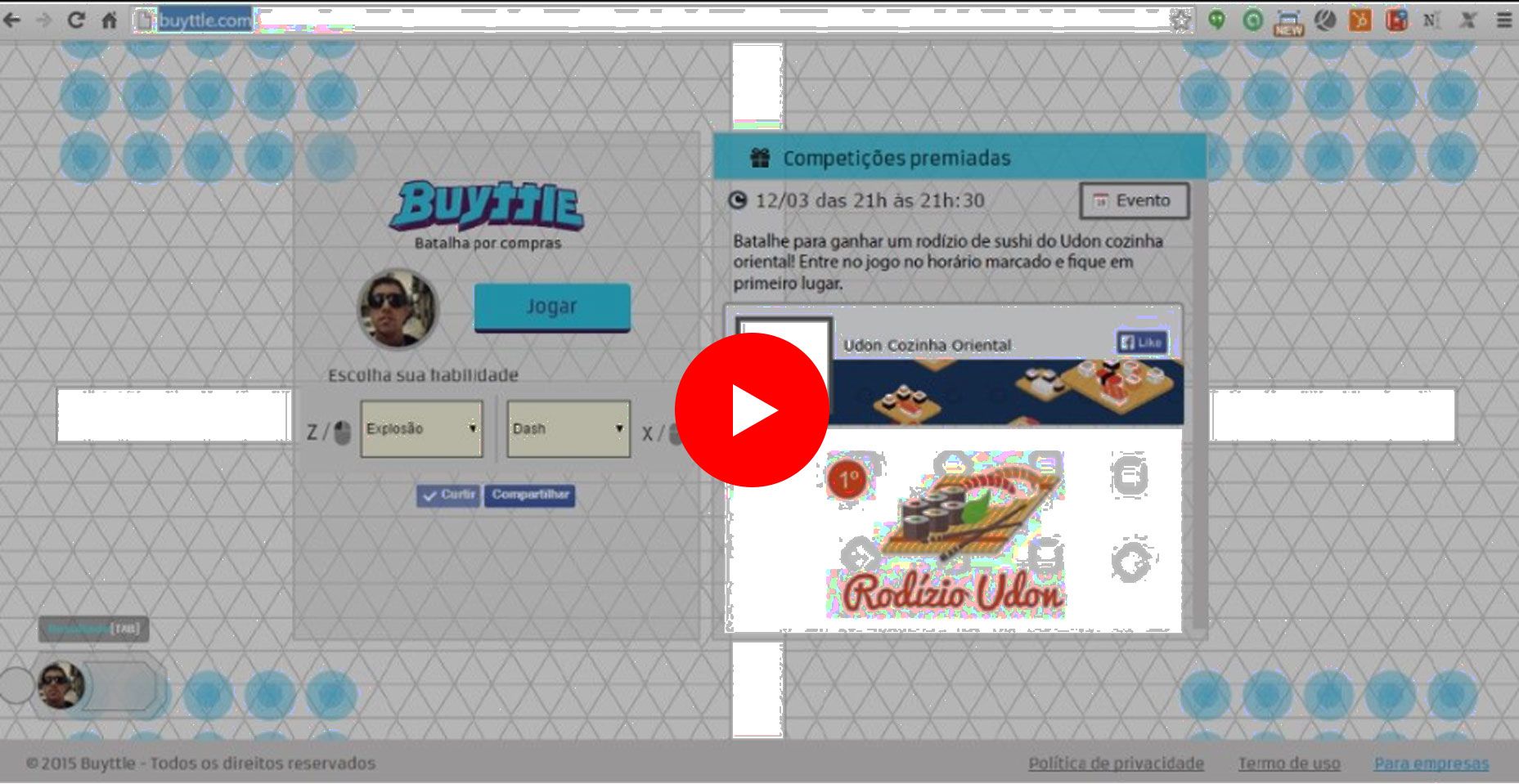
Buyttle - Battle for prizes
A platform for real prize battles. A personal project that evolved into a company where I served as CEO and co-founder. The project was approved by Start-Up Brasil and received investment from the accelerated CESAR Labs.
Buyttle v1
My Role and Team
In the first version of Buyttle, the team initially consisted of just me, serving as the designer, and later on, Luciano Firmino joined as the developer.
The Project
Buyttle was a website where people could battle for real prizes through a simple and casual real-time multiplayer game.
The Process
To create the first version of Buyttle, after graduating from college, I dedicated myself to studying game design and gamification. I conducted extensive research on casual games to find the ideal mechanics and visual references for the project, despite my limited illustration skills at the time. Designing the entire illustrated interface and its animations proved to be a significant challenge. I worked on this project during my free time while also being employed at CESAR.
The Game
The first version of Buyttle was a game that worked like a tug-of-war. To defeat the opponent, one had to attach the crown to their magnet.

Some balls with different arrow indications would emerge alternately from a source in varying quantities and random frequencies.
The player needed to hit the corresponding arrow key on the keyboard at the exact moment the arrow on the ball aligned with a specific point indicated along its path.
When this happened, the ball would burst and serve as fuel to activate the magnet, pulling the crown towards the correct direction.
When the crown reached the magnet of the victorious player, the losing player would be expelled, and a 60-second countdown would begin to wait for new challengers.
To win the prize, there should be no challengers until the end of that countdown, and to enter the game again, players needed to use new tokens, which were sold on the website and served as the business's source of revenue.
User Testing
Together with Luciano Firmino, we developed an MVP of the website and organized some in-person events for validation tests. We wanted to find out if people would buy tokens, how much they would spend, and how long they would play a simple and "challenging" game. We invited a group of 10 people, set up two computers, offered a prize, and explained the dynamics. Each player received 10 free tokens, and we sold token packages to those who wanted to buy more.
The battles lasted an average of 5 hours, and we recorded all the dynamics for later analysis. We conducted semi-structured interviews, asking questions to understand their motivations, sensations, and feelings. The feedback obtained provided numerous insights, helping us identify various issues and ideas for improvements. With the compiled data, we proceeded to create a fundraising project for Buyttle.
Buyttle V
We wrote the project for Startup Brasil with the idea of creating a second improved version that addressed some of the problems found during testing. The main goal of the second version was to increase the number of participants in the game so that the prize amounts could be larger and also to resolve the issue of the game feeling "challenging."
The Process
We conducted benchmarking on various games, considering different factors, and ultimately decided on a simple and fun game for four people to play simultaneously. We invested in a new dynamic so that players would win prizes based on their skills, without relying on a pay-to-win approach.
I created the initial mockup to illustrate the project for Startup Brasil, combining the concepts of the crown and time with the new gameplay mechanics.
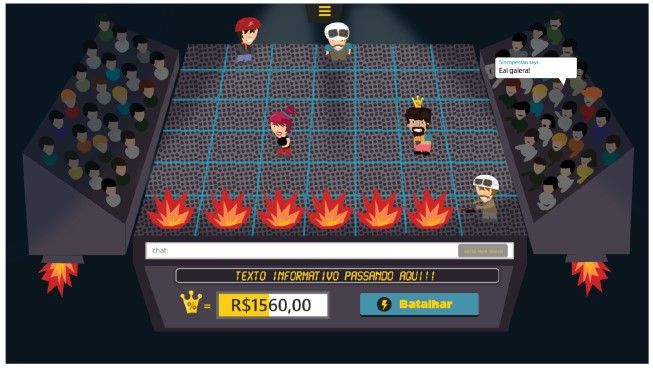
The game concept remained quite simple. An arena with a crown in the middle, and the objective was to enter, grab the crown, and hold it for 60 seconds to win the prize.
Up to 4 players could be in the arena simultaneously. Players could shoot fire in straight lines, and they needed skill to dodge attacks from opponents. If they were hit, they would be expelled from the arena and had to pay a token to return.
One of the innovative aspects of this version was that the audience could influence the game by voting to throw items into the arena, either hindering or helping the players.
The project was approved by Start-Up Brasil, and CESAR Labs became our investor.
From there, we hired developers, an illustrator designer, and began working on developing the first prototype of the online game.
My Role and the Team
During this phase, I was the CEO and decision-maker of the company. As a designer, I was directly involved in the game and platform creation. Additionally, I performed tasks such as personnel recruitment, team management, contract negotiations, representing the company at events, and attending meetings with investors and acceleration mentors. The team consisted of myself as the designer, three developers, and an illustrator.
User Testing V2
The second game was launched as an MVP, still lacking visual quality and incomplete, for a closed community on Facebook.
We started selling token packages on the website and held battles approximately twice a week at different times.
However, we soon realized that due to the limited number of people in the group, it was challenging to gather the minimum number of players required for the game to be profitable. We ended up spending more on prizes than the revenue generated from token sales.
In this context, we were invited to exhibit at Campus Party, one of the world's largest technology events, and we decided to seize this opportunity to conduct a large-scale test. We managed to secure some sponsors to provide the prizes for the battles and attended the event.
During the event, we distributed over a thousand free tokens, which resulted in a significant success in terms of reach. The participation and interest exceeded our expectations.

I remember being amazed at one point when I realized that there were more people playing Buyttle than playing League of Legends. We even made an appearance on Brazil's main television news channel.

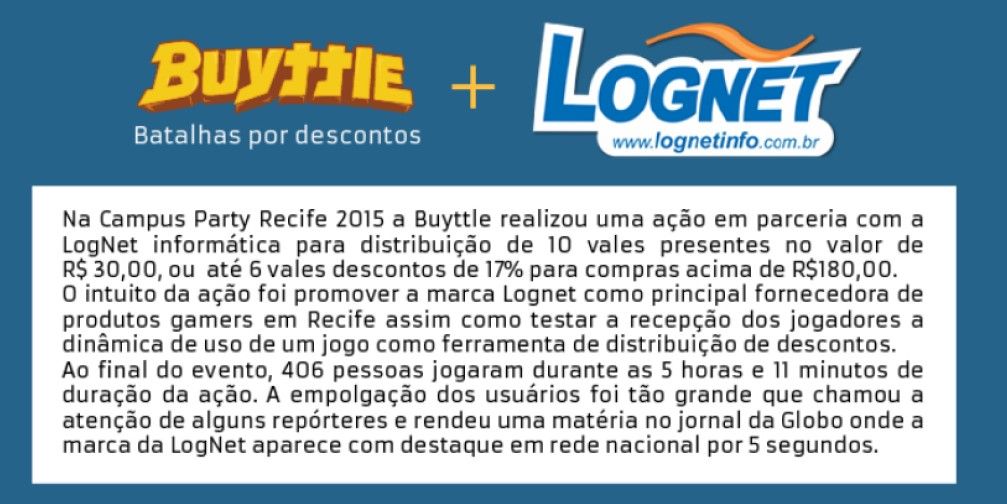
Based on the success of this case, proven by the reach and interest shown by companies willing to sponsor us, we reached the conclusion that we should create a game for an even broader audience to reach a larger user base.
Buyttle v3
The third and final version of Buyttle was a game where up to 30 people could play simultaneously. We held weekly battles with prizes offered by small local businesses such as restaurants, sushi bars, pizzerias, burger joints, and computer equipment stores.
Our goal was to create a casual, real-time game that was easy to learn but difficult to master.
It was a free advergame, designed to be easily customized with visual elements from any brand that wanted to sponsor it. The design and animations, created by me, were minimalist, and the entire focus was on providing a fun gameplay experience.
Results
We launched the game as an open and free version and managed to conduct some sponsored battles that were promoted on social media, both by us and our sponsors.
Through these battles, we gained some followers, but it required continuous sales efforts to constantly attract new partners. The high costs of sales and development, coupled with the low revenues from sales, made the business unsustainable.
Unfortunately, this final attempt to find a sustainable business model in the gaming industry did not succeed, and we decided to close the company before incurring losses.
Lessons Learned
As a young and inexperienced entrepreneur, there are several aspects that I would have approached differently:
-
With the investment we had, we focused too much on developing complex games instead of working on revenue generation. In hindsight, I would have implemented short-term profit strategies and faced the fear of potential failures.
-
Not investing in marketing from the beginning prevented us from learning how to attract our customers effectively. Launching the first two versions of the website and using adwords, social media, and referral systems to acquire customers would have been more valuable than conducting closed test groups.
-
In each version, we didn't fully explore all possible solutions to the problems that arose. Opting to start from scratch with each problem, between development and testing, consumed a lot of time.
-
We lacked the ability to prototype solutions quickly and cost-effectively and validate the business before building the games. Despite attempting to create simple and unfinished games, game development is time-consuming. More research and a faster approach to validating our hypotheses would have been necessary.
On the positive side, I believe that this intense journey was extremely enriching. It provided me with valuable learning experiences in leadership, teamwork, and people management. I also had the opportunity to study and apply business concepts, UX research, Lean UX, and Lean Startup, which contributed to my growth as a designer and manager.
Despite our inexperience, I believe we did a good job applying a rational method of evaluation and improvement based on tests with real people.
I also value the experience of selling the idea, raising resources, building the team, and, despite being a complex project, being able to execute it.
